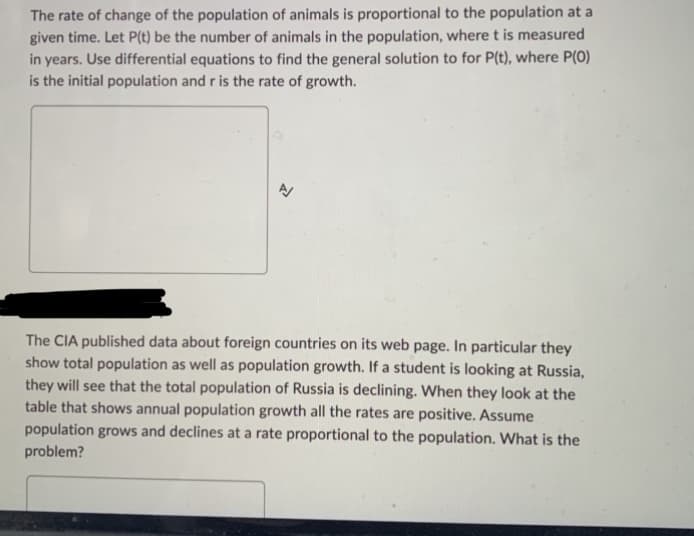The rate of change of the population of animals is proportional to the population at a given time. Let P(t) be the number of animals in the population, where t is measured in years. Use differential equations to find the general solution to for P(t), where P(0) is the initial population and r is the rate of growth.
The rate of change of the population of animals is proportional to the population at a given time. Let P(t) be the number of animals in the population, where t is measured in years. Use differential equations to find the general solution to for P(t), where P(0) is the initial population and r is the rate of growth.
Calculus: Early Transcendentals
8th Edition
ISBN:9781285741550
Author:James Stewart
Publisher:James Stewart
Chapter1: Functions And Models
Section: Chapter Questions
Problem 1RCC: (a) What is a function? What are its domain and range? (b) What is the graph of a function? (c) How...
Related questions
Question
Please explain how to solve both, thank you!

Transcribed Image Text:The rate of change of the population of animals is proportional to the population at a
given time. Let P(t) be the number of animals in the population, where t is measured
in years. Use differential equations to find the general solution to for P(t), where P(0)
is the initial population and r is the rate of growth.
N
The CIA published data about foreign countries on its web page. In particular they
show total population as well as population growth. If a student is looking at Russia,
they will see that the total population of Russia is declining. When they look at the
table that shows annual population growth all the rates are positive. Assume
population grows and declines at a rate proportional to the population. What is the
problem?
Expert Solution
This question has been solved!
Explore an expertly crafted, step-by-step solution for a thorough understanding of key concepts.
Step by step
Solved in 3 steps

Recommended textbooks for you

Calculus: Early Transcendentals
Calculus
ISBN:
9781285741550
Author:
James Stewart
Publisher:
Cengage Learning

Thomas' Calculus (14th Edition)
Calculus
ISBN:
9780134438986
Author:
Joel R. Hass, Christopher E. Heil, Maurice D. Weir
Publisher:
PEARSON

Calculus: Early Transcendentals (3rd Edition)
Calculus
ISBN:
9780134763644
Author:
William L. Briggs, Lyle Cochran, Bernard Gillett, Eric Schulz
Publisher:
PEARSON

Calculus: Early Transcendentals
Calculus
ISBN:
9781285741550
Author:
James Stewart
Publisher:
Cengage Learning

Thomas' Calculus (14th Edition)
Calculus
ISBN:
9780134438986
Author:
Joel R. Hass, Christopher E. Heil, Maurice D. Weir
Publisher:
PEARSON

Calculus: Early Transcendentals (3rd Edition)
Calculus
ISBN:
9780134763644
Author:
William L. Briggs, Lyle Cochran, Bernard Gillett, Eric Schulz
Publisher:
PEARSON

Calculus: Early Transcendentals
Calculus
ISBN:
9781319050740
Author:
Jon Rogawski, Colin Adams, Robert Franzosa
Publisher:
W. H. Freeman


Calculus: Early Transcendental Functions
Calculus
ISBN:
9781337552516
Author:
Ron Larson, Bruce H. Edwards
Publisher:
Cengage Learning